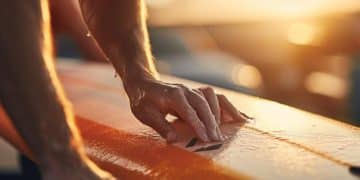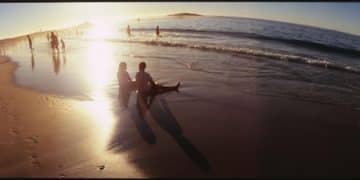Learn to Windsurf: Your 7-Day Beginner Training Plan to Ride Waves
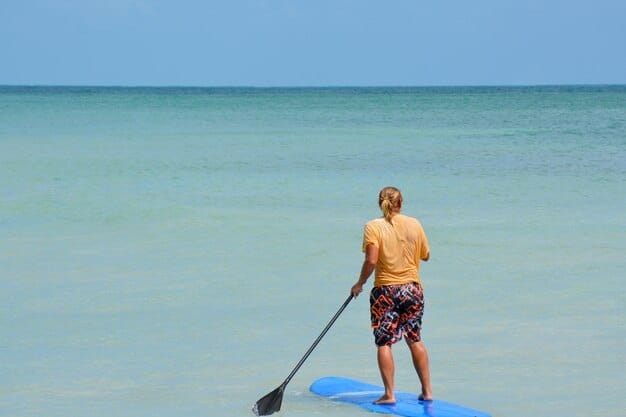
Mastering windsurfing as a beginner is achievable within seven days by following a structured training plan that covers essential skills from equipment handling to riding the waves efficiently and safely.
Embarking on the journey to Learn to Windsurf: A 7-Day Training Plan for Beginners to Ride the Waves offers an exhilarating path to mastering an iconic water sport. This guide provides a comprehensive, week-long program designed to transform aspiring windsurfers into confident wave riders, focusing on practical skills and safety.
Day 1: Getting Acquainted – Theory and Land Drills
Learning to windsurf begins not in the water, but on solid ground, where the fundamentals can be absorbed without the added challenges of balance and current. Day one is crucial for building a foundational understanding of the equipment, wind dynamics, and basic maneuvers that will be performed later. This initial theoretical groundwork coupled with practical land-based exercises vastly accelerates the learning process once you hit the water.
Understanding the components of a windsurfing rig is paramount. Familiarize yourself with the board, sail, mast, boom, and fin. Each part plays a specific role in how the board interacts with the wind and water. Paying close attention to how these components fit together and their individual functions will demystify the mechanics of windsurfing.
The wind always dictates the movement in windsurfing, making wind awareness a critical skill. Learn about wind direction, apparent wind, and true wind. Identify how to estimate wind strength and read flag or water signals. Understanding how the wind interacts with your sail will empower you to control your movement on the water effectively from the very beginning.
Equipment Assembly and Rigging
Properly assembling your gear ensures safety and optimal performance. This involves connecting the mast to the sail, attaching the boom, and securing the fin to the board. Learn the correct tension settings for the downhaul and outhaul lines, as these greatly influence sail shape and power.
- Identify each part of the windsurfing rig.
- Practice assembling the mast, boom, and sail.
- Understand how fin attachment impacts stability.
Basic Land Simulations
Before getting wet, practice critical movements on land. Simulate pulling the sail out of the water (uphauling), getting into the sailing position, and steering. These drills help build muscle memory and coordination in a controlled, stable environment, reducing anxiety for the actual water sessions.
- Practice the uphaul technique using a simulated board.
- Mimic the sailing stance to find your balance point.
- Perform simulated turns to familiarize with body movements.
The first day’s focus on land-based learning establishes a robust mental and physical blueprint for the subsequent days. By mastering the theoretical aspects and performing crucial land drills, you are setting yourself up for success and significantly reducing potential frustrations when it’s time to brave the waves. This meticulous preparation makes the transition to water smoother and more intuitive, paving the way for rapid progress.
Day 2: First Immersion – Balance and Uphauling
Upon entering the water on Day 2, the primary goal is to establish a strong sense of balance on the windsurf board and master the uphaul technique. The uphaul, which involves pulling the sail out of the water, is arguably the most fundamental skill for beginners. Without it, continuous windsurfing is impossible. Calm, shallow waters are ideal for this initial immersion, providing a stable and safe environment for repeated practice.
The sensation of floating on the board, with the waves gently rocking beneath, requires a mental and physical adjustment. Your center of gravity will shift, and maintaining stability becomes a constant, nuanced effort. This day is less about forceful movements and more about finding a dynamic equilibrium.
Finding Your Footing on the Board
Begin by simply kneeling or lying on the board without the sail, getting accustomed to its buoyancy and stability. Gradually, attempt to stand up, using the mast base as a point of balance. Practice shifting your weight slightly to feel how the board responds. The goal is to feel comfortable and upright before introducing the sail into the equation.
Mastering the Uphaul Technique
The uphaul is a series of coordinated movements: leaning forward, grabbing the uphaul rope, and systematically pulling the sail up, allowing the water to drain. It requires patience and persistence. Focus on using your body weight, not just your arms, to conserve energy.
As you stand on the board, keep your knees slightly bent and feet parallel, positioned on either side of the mast track. This wider stance provides a more stable base. Your gaze should be directed forward, not down at your feet, to help maintain balance.
Begin by reaching for the uphaul rope, keeping your weight centered. Pull the sail steadily, allowing the water to drain as it rises. As the sail clears the water, shift your grip to the boom, ensuring your hands are one on each side. The goal is to bring the sail to a vertical position, ready for sailing. Many beginners find themselves falling back into the water repeatedly during this stage, which is completely normal. Each fall is a learning opportunity, refining your balance and uphaul technique. The consistent repetition of these two skills will build the necessary core strength and proprioception for future maneuvers.
Day 3: Basic Sailing – Steering and Control
With a solid grasp of balance and uphauling from Day 2, Day 3 sees you moving under rudimentary sail power. This stage introduces the art of steering and speed control, transforming you from a passive floating object into an active participant. The focus remains on gentle wind conditions and flat water to ensure a forgiving learning environment.
Steering in windsurfing is primarily achieved by tilting the sail forward or backward relative to the board, a concept known as “sheeting in” or “sheeting out.” Pushing the sail forward (towards the nose of the board) will cause the board to bear away (turn downwind), while pulling it back (towards the tail) will make the board head up (turn upwind). This subtle interplay between sail and board demands conscious effort and practice.
Entering the Basic Sailing Stance
Once the sail is uphauled, position yourself properly on the board. One foot should be slightly forward of the mast base, and the other aft, creating a stable platform. Your knees remain bent, and the body leans slightly away from the mast, applying counter-pressure to the sail’s pull. Your hands are on the boom, forming a triangular shape with your arms, allowing fine control over the sail.
Developing Steering Control
Practice turning the board left and right using subtle shifts in sail angle and body weight. Start with small adjustments and gradually increase the turning radius. The key is to feel how the board responds to these inputs. The goal is to be able to sail a straight line and then initiate graceful turns in both directions.
Controlling Board Speed
Speed is regulated by how much the sail catches the wind. Sheeting the sail in (pulling it closer to your body) catches more wind, increasing speed. Sheeting out (letting it away from your body) reduces wind capture, slowing the board down. Mastering this control is vital for safety and maneuvering.
Throughout Day 3, the emphasis is on repetition and muscle memory. The ability to consistently steer and control your speed, even in gentle breezes, fosters confidence. It transforms the intimidating rig into an extension of your body. Expect many falls, but each one refines your balance and understanding of the forces at play, slowly but surely paving the way for more advanced maneuvers. By the end of this day, you should be able to sail a short distance, turn, and return to your starting point, albeit perhaps with some paddling involved.
Day 4: Turning Techniques – The Gybe and the Tack
Day 4 marks a significant milestone: learning to turn the board completely around against or with the wind. The two fundamental turning techniques are the gybe (or jibe) and the tack. The gybe turns the board downwind, while the tack turns it upwind, through the eye of the wind. Mastering these maneuvers allows you to sail in any direction and return to your starting point, granting much greater freedom on the water.
Both techniques demand a sequence of coordinated movements involving the sail, board, and body weight. They require anticipation and smooth transitions to maintain momentum throughout the turn. Patience is key, as these are often the first major hurdles for new windsurfers.
Introduction to the Gybe (Downwind Turn)
The gybe is typically introduced first, as it’s often considered more intuitive for beginners. It involves turning the board away from the wind, with the sail crossing over the nose of the board. The key is to initiate the turn by leaning the sail and board, and then stepping around the mast, allowing the sail to swing to the other side.
Practice the gybe motion slowly, focusing on each step of the rotation. Ensure your feet are positioned correctly to facilitate the turn and that your hands are ready to switch positions on the boom. The speed of the turn is crucial; too slow, and you might lose momentum; too fast, and you might lose control.
Introduction to the Tack (Upwind Turn)
The tack involves turning the board directly into the wind, with the nose of the board passing through the wind’s direction. This maneuver requires precise timing and balance, as the wind can momentarily destabilize the sail. The sail will “flap” as it passes through the eye of the wind, and you’ll need to step around the mast to the new side.
Similar to the gybe, practice the tack in segments. Focus on maintaining a strong, balanced stance as you pivot the board into the wind. The point at which the sail flips sides is critical; be ready to adjust your grip and weight rapidly to gain stability on the new course.
Initially, you might fall frequently during both gybes and tacks. This is part of the learning curve. Each repeated attempt refines your balance, timing, and understanding of how your body and the rig interact with the wind during these dynamic maneuvers. By the end of Day 4, you should have a basic understanding and some successful attempts at both turning techniques, even if they aren’t yet consistently smooth.
Day 5: Refining Turns and Upwind Sailing
Building upon the previous day’s introduction to turning techniques, Day 5 is dedicated to refining your gybes and tacks, aiming for smoother, more controlled transitions. This is also the day to seriously tackle upwind sailing (sailing against the wind), a crucial skill for returning to your starting point or navigating against currents. Mastering upwind sailing means you can effectively sail back to your launch point without needing to swim or walk.
Refining turns involves not just completing the maneuver, but doing so gracefully and with minimal loss of speed or balance. It means anticipating the wind conditions and adjusting your body and sail accordingly throughout the turn. Upwind sailing, also known as “sailing close-hauled,” requires precise sail trim and body positioning.
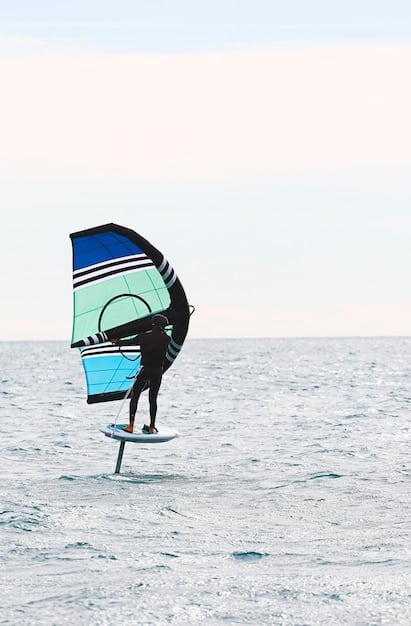
Improving Gybes and Tacks
Practice both gybes and tacks repeatedly, focusing on the fluidity of your movements. Start by exaggerating each step, then gradually streamline them. Pay attention to your head and body movements, as they often dictate the board’s direction. The goal is to minimize momentum loss during the turn and exit cleanly onto the new course.
Consider the role of your boom hand (the back hand) in the gybe, “pushing” the sail through the turn, and your mast hand (front hand) in the tack, which guides the sail as it pivots. Subtle weight shifts are also vital.
The Art of Upwind Sailing (Close-Hauled)
Sailing upwind means sailing as close to the wind as possible without losing forward momentum. This requires sheeting the sail in tightly (pulling it very close to your body) and leaning your body away from the rig to counteract the pull. Your board should point towards the wind source as much as possible, effectively cutting across the wind.
The angle of your board relative to the wind is crucial. Experiment with small adjustments to your feet and sail angle until you find the “sweet spot” where you are moving forward efficiently while pointing as high into the wind as possible. This often feels counter-intuitive initially, as it requires sailing towards the direction the wind is coming from.
- Focus on a smooth, continuous motion throughout the gybe.
- Practice the tack with careful timing as the sail crosses the wind.
- Experiment with sail trim for optimal upwind progression.
- Maintain a low, strong posture to counteract sail pull when sailing close-hauled.
By the end of Day 5, you should feel more confident in navigating the water, capable of heading in a chosen direction and effectively returning to your starting point. The improvements in your turning techniques and the ability to sail upwind provide a significant psychological boost, as you are now truly able to control your movement across the water.
Day 6: Harnessing Power – Beach Starts and Footstraps
Day 6 brings two significant advancements that enhance efficiency and control: the beach start and the use of footstraps. The beach start eliminates the need for uphauling in shallow water, saving energy and allowing for a quicker launch. Footstraps, on the other hand, provide a direct connection between you and the board, enabling more powerful and controlled sailing, particularly when the wind strengthens.
These skills are typically introduced once a solid foundation in basic sailing and turning has been established, as they require a greater degree of balance and confidence. They are game-changers for progression, allowing you to venture into choppier conditions and experience the full thrill of windsurfing.
The Beach Start
The beach start is a more elegant and less energy-intensive way to get going from shallow water. Instead of pulling the sail out of the water, you stand on the board, hold the sail, and use the wind to lift it and propel you forward. It involves positioning the board and sail optimally relative to the wind, then pushing off the bottom with your feet.
Practice the beach start by placing your back foot on the board and using the wind to pull the sail up and forward. As the sail fills with wind, step your front foot onto the board and lean into the sail’s pull to gain momentum. This technique requires timing and coordination but is incredibly rewarding once mastered.
Introduction to Footstraps
Footstraps are loops on the board that you slide your feet into. They connect you securely to the board, allowing you to lean further out into the wind (sheet out) and use your body weight more effectively to counteract the sail’s pull. This provides immense power and control, especially in higher winds.
Initially, simply practice putting your feet into and out of the footstraps while sailing in a straight line. It feels awkward at first, as it restricts your ability to move your feet. Once comfortable, experiment with leaning further back and using your body weight to harness more power. This opens up opportunities for greater speed and more dynamic sailing.
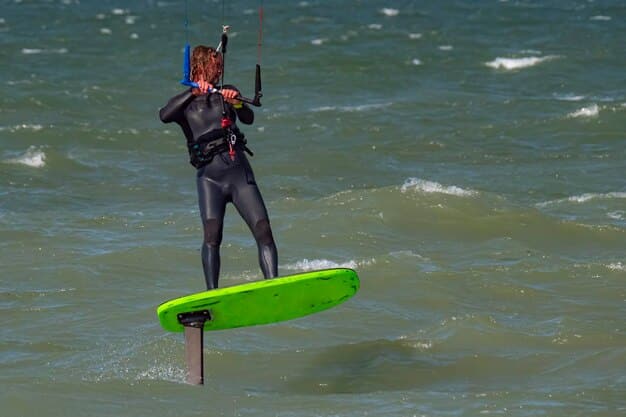
Both the beach start and the use of footstraps significantly reduce physical exertion and increase the enjoyment of windsurfing. The ability to launch from the beach without uphauling saves valuable energy that can be put towards more sailing. Similarly, footstraps allow you to control powerful winds, making the ride more thrilling and efficient. By the end of Day 6, you will be feeling more like a true windsurfer, capable of harnessing greater speeds and navigating with improved technique.
Day 7: Consolidating Skills and Advanced Exploration
Day 7 is about consolidating all the skills learned throughout the week and beginning to explore more advanced aspects of windsurfing. This day focuses on increasing your time on the water, refining your technique in varying conditions, and perhaps even attempting your first planing experience or venturing further from shore with confidence.
The goal is to integrate all the individual skills—balance, uphauling, steering, gybing, tacking, beach starting, and using footstraps—into a fluid, natural sailing experience. This builds confidence and prepares you for continued progression beyond the beginner stage.
Extended Water Time and Varied Conditions
Spend a significant amount of time on the water, practicing everything you’ve learned. If conditions allow, try sailing in slightly choppier water or a slightly stronger breeze than you’ve previously encountered. This helps adapt your technique to different environments and builds resilience.
Focus on the smoothness of your transitions between maneuvers. Can you link a tack directly into a gybe? Can you smoothly enter and exit footstraps while sailing at speed? These fluid connections are hallmarks of an improving windsurfer.
Introduction to Planing (Optional)
If wind conditions are sufficient (typically around 15+ knots), you might get your first taste of planing. Planing is when the board rises partly out of the water and skims across the surface, creating an exhilarating sensation of speed. It requires strong wind, proper sail trim, and body position, leaning back and “flying” the board. This is an advanced skill, and if the conditions aren’t right, don’t force it; there will be plenty of time for it later.
Exploring the Sailing Area
With newfound confidence in your ability to return to shore (thanks to upwind sailing and turns), you can begin to explore further within the designated sailing area. This helps develop your spatial awareness on the water and your ability to read the wind and water conditions across a wider expanse. This is where the true joy of windsurfing begins to unfold, as you feel more connected to the elements and capable of navigating the open water.
Upon completing this 7-day training plan, you will have a solid foundation in windsurfing. You’ll be able to launch, sail in chosen directions, turn, and return to shore safely. This intensive week prepares you not just to ride the waves, but to truly enjoy the freedom and challenge that windsurfing offers. Remember that practice is key, and every session builds upon the last, solidifying your skills and opening the door to even more advanced techniques in the future.
| Key Skill | Brief Description |
|---|---|
| 🌬️ Wind Awareness | Understanding wind direction and strength is crucial for control. |
| 🏃 Land Drills & Uphauling | Practice essential movements on land and master pulling the sail up from water. |
| 🔄 Turning Techniques | Learn to gybe (downwind turn) and tack (upwind turn) for full directional control. |
| 🚀 Beach Starts & Footstraps | Efficiently launch from shore and connect to the board for enhanced power and control. |
Frequently Asked Questions
▼
While windsurfing requires coordination and balance, modern beginner equipment is designed to be very stable and forgiving. Consistent practice, especially in light winds and shallow water, can lead to rapid progress. Many people can get sailing short distances within a day or two of dedicated instruction.
▼
For beginners, essential gear includes a wide, stable board, a relatively small, light sail, a mast, boom, and fin. You’ll also need a wetsuit for warmth, a personal flotation device (PFD) for safety, and potentially a helmet. Rental packages at windsurfing schools typically provide well-suited beginner equipment.
▼
Very important. Beginners should start in light, consistent winds, typically 5-12 knots. Stronger winds can be overwhelming and frustrating, making it harder to balance and control the sail. As you progress, you can gradually move to windier conditions, but gentle breezes are ideal for mastering the fundamentals.
▼
While possible to self-teach with instructional videos and guides, formal lessons are highly recommended. Instructors provide immediate feedback, correct mistakes, and ensure proper technique from the start, which significantly accelerates learning and reduces the risk of developing bad habits. They also ensure safety on the water.
▼
Common challenges include maintaining balance, executing the uphaul efficiently without excessive effort, learning to turn effectively (gybe and tack), and understanding how to read and use the wind correctly. Patience and persistence are key, as overcoming these hurdles leads to significant satisfaction and progress.
Conclusion
The journey to mastering windsurfing, encapsulated within this 7-day training plan, is a rewarding testament to perseverance and structured learning. From understanding the nuances of equipment on land to confidently carving turns and harnessing the wind’s power on the water, each day builds a vital layer of skill and confidence. While the waves may seem formidable at first, diligent practice and a methodical approach transform apprehension into exhilaration. Embrace the falls as lessons, celebrate every small victory, and soon you’ll be riding the waves with a newfound sense of freedom and accomplishment, ready for endless adventures on the water.
